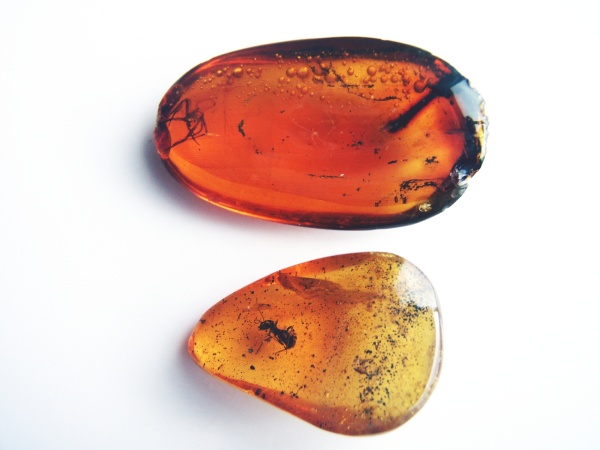
12 December 2013
Amber is a rock that started as tree resin. When it was resin it collected pollen, flecks of dirt, plants, small creatures, and other debris as it flowed from the tree. The amber above contains a spider, air bubbles, dirt and an ant, all preserved when the resin hardened.
Scientists are fascinated by amber because everything inside it is as old as the rock. In 2013 an international team led by Ralf Tappert of the University of Innsbruck analyzed carbon-12 and carbon-13 in present-day tree resin and amber dating all the way back to the Triassic period. They chose amber for their chemical analysis because, as Tappert explains, “Compared to other organic matter, amber has the advantage that it remains chemically and isotopically almost unchanged over long periods of geological time.”
From 538 samples they calculated the concentration of oxygen in the atmosphere for 220 million years of the Earth’s history. Surprisingly, they learned that the concentration in the early Cretaceous period was only 10-15% compared to 21% oxygen today. The dinosaurs had less oxygen to breathe than we do!
This finding tossed out at least one theory about the dinosaurs, namely that their size was possible because they had so much more oxygen to breathe. Oops! They had less.
Click here to read more about the study at ABC Science (Australia).
Ancient air tells the tale.
(photo from Wikimedia Commons. Click on the image to see the original)
p.s. The concentration of oxygen in the Cretaceous was similar to the effective oxygen percentage at the top of Pikes Peak or Mt Everest Base Camp.
Very interesting post as yours usually are causing me to visit each day. Thanks for your efforts. Living in Western Kentucky I have never observed a Perigrine Falcon until today. This week I had been focusing on Bald Eagles. Today had me on the western bank of the Tennesse river. Below Kentucky Dam which has two recently built bridges over the tailwaters. A spot chosen as a good location to observe eagles picking up fish. Towards the end of the day what looked like a small hawk whizzed past, gulls scattered and in an instant after a couple maneuvers the hawk caught what I thought was a gull. It carried it back up river towards the bridges. It dropped its catch, then I noticed a pair of eagles swinging in to pick up the dropped bird. When I uploaded the photos I took of the event I was surprised to see that it was not a hawk but a Perigrine Falcon. When an eagle picked up the dropped bird it too dropped it and the photos showed it was a pigeon of which there are many that reside on the bridges. Being interested in perigrines I thought you might want to visit my website goatsass.com and read the story. The photos are not the best at the distances they were shot but good enough for indentification. Thanks for your time and the interesting subjects you provide daily.